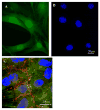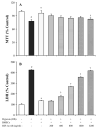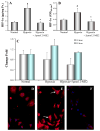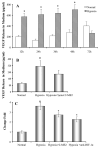HIF-1alpha induced-VEGF overexpression in bone marrow stem cells protects cardiomyocytes against ischemia
- PMID: 17498737
- PMCID: PMC1995444
- DOI: 10.1016/j.yjmcc.2007.04.001
HIF-1alpha induced-VEGF overexpression in bone marrow stem cells protects cardiomyocytes against ischemia
Abstract
Hypoxia inducible factor-1alpha (HIF-1alpha) is a proangiogenic transcription factor stabilized and activated under hypoxia. It regulates the expression of numerous target genes, including vascular endothelial growth factor (VEGF) and other cytoprotective proteins. In this study, we hypothesized that bone marrow stem cells (BMSCs) secrete growth factors which protect cardiomyocytes via HIF-1alpha pathway. BMSCs were obtained from transgenic mice overexpressing green fluorescent protein (GFP). The study was carried out in vitro using co-culture of BMSCs with cardiomyocytes. LDH release, MTT uptake, DNA fragmentation and annexin-V positive cells were used as cell injury markers. The level of HIF-1alpha protein as well as its activated form and VEGF were measured by ELISA. The expression of HIF-1alpha and VEGF in BMSCs was analyzed by quantitative PCR and cellular localization was determined by immunohistochemistry. LDH release was increased and MTT uptake was decreased after exposure of cardiomyocytes to hypoxia for 30 h, which were prevented by co-culturing cardiomyocytes with BMSCs. Cardiomyocyte apoptosis induced by hypoxia and H(2)O(2) was also reduced by co-culture with BMSCs. VEGF release from BMSCs was significantly increased in parallel with high level of HIF-1alpha in BMSCs following anoxia or hypoxia in a time-dependent manner. Although no significant up-regulation could be seen in HIF-1alpha mRNA, HIF-1alpha protein and its activated form were markedly increased and translocated to the nucleus or peri-nuclear area. The increase and translocation of HIF-1alpha in BMSCs were completely blocked by 2-methoxyestradiol (2-ME2; 5 mumol), a HIF-1alpha inhibitor. Moreover, the protection of cardiomyocytes by BMSC and VEGF secretion was abolished by neutralizing HIF-1alpha antibody in a concentration dependent manner (200-3200 ng/ml). Bone marrow stem cells protect cardiomyocytes by up-regulation of VEGF via activating HIF-1alpha.
Conflict of interest statement
There are no conflicts of interest
Figures








Similar articles
-
Hypoxia-inducible factor 1-α-AA-modified bone marrow stem cells protect PC12 cells from hypoxia-induced apoptosis, partially through VEGF/PI3K/Akt/FoxO1 pathway.Stem Cells Dev. 2012 Sep 20;21(14):2703-17. doi: 10.1089/scd.2011.0604. Epub 2012 May 17. Stem Cells Dev. 2012. PMID: 22468883 Free PMC article.
-
Cellular repressor of E1A-stimulated gene overexpression in bone mesenchymal stem cells protects against rat myocardial infarction.Int J Cardiol. 2015 Mar 15;183:232-41. doi: 10.1016/j.ijcard.2015.01.059. Epub 2015 Jan 27. Int J Cardiol. 2015. PMID: 25679992
-
In vitro and in vivo effects of bone marrow stem cells on cardiac structure and function.J Mol Cell Cardiol. 2007 Feb;42(2):441-8. doi: 10.1016/j.yjmcc.2006.10.009. Epub 2006 Dec 20. J Mol Cell Cardiol. 2007. PMID: 17187821 Free PMC article.
-
Salidroside protects cardiomyocyte against hypoxia-induced death: a HIF-1alpha-activated and VEGF-mediated pathway.Eur J Pharmacol. 2009 Apr 1;607(1-3):6-14. doi: 10.1016/j.ejphar.2009.01.046. Eur J Pharmacol. 2009. PMID: 19326475
-
Mesenchymal Stem Cells and Cardiomyocytes Interplay to Prevent Myocardial Hypertrophy.Stem Cells Transl Med. 2015 Dec;4(12):1425-35. doi: 10.5966/sctm.2015-0032. Epub 2015 Nov 19. Stem Cells Transl Med. 2015. PMID: 26586774 Free PMC article.
Cited by
-
Electrically Induced Calcium Handling in Cardiac Progenitor Cells.Stem Cells Int. 2016;2016:8917380. doi: 10.1155/2016/8917380. Epub 2016 Oct 12. Stem Cells Int. 2016. PMID: 27818693 Free PMC article.
-
Synergistically combined gene delivery for enhanced VEGF secretion and antiapoptosis.Mol Pharm. 2013 Oct 7;10(10):3676-83. doi: 10.1021/mp400178m. Epub 2013 Sep 23. Mol Pharm. 2013. PMID: 24007285 Free PMC article.
-
Indispensable Role of HIF-1α Signaling in Post-implantation Survival and Angio-/Vasculogenic Properties of SHED.Front Cell Dev Biol. 2021 Jul 23;9:655073. doi: 10.3389/fcell.2021.655073. eCollection 2021. Front Cell Dev Biol. 2021. PMID: 34368116 Free PMC article.
-
Lysophosphatidic acid protects human mesenchymal stromal cells from differentiation-dependent vulnerability to apoptosis.Tissue Eng Part A. 2014 Apr;20(7-8):1156-64. doi: 10.1089/ten.TEA.2013.0487. Epub 2014 Feb 11. Tissue Eng Part A. 2014. PMID: 24131310 Free PMC article.
-
HIF-1α Overexpression Induces Angiogenesis in Mesenchymal Stem Cells.Biores Open Access. 2012 Aug;1(4):174-83. doi: 10.1089/biores.2012.9905. Biores Open Access. 2012. PMID: 23514846 Free PMC article.
References
-
- Xue T, Cho HC, Akar FG, Tsang SY, Jones SP, Marban E, et al. Functional integration of electrically active cardiac derivatives from genetically engineered human embryonic stem cells with quiescent recipient ventricular cardiomyocytes: insights into the development of cell-based pacemakers. Circulation. 2005 Jan 4;111(1):11–20. - PubMed
-
- Wang Y, Haider H, Ahmad N, Zhang D, Ashraf M. Evidence for ischemia induced host-derived bone marrow cell mobilization into cardiac allografts. J Mol Cell Cardiol. 2006 Sep;41(3):478–87. - PubMed
-
- Uemura R, Xu M, Ahmad N, Ashraf M. Bone marrow stem cells prevent left ventricular remodeling of ischemic heart through paracrine signaling. Circ Res. 2006 Jun 9;98(11):1414–21. - PubMed
-
- Fukuda K, Fujita J. Mesenchymal, but not hematopoietic, stem cells can be mobilized and differentiate into cardiomyocytes after myocardial infarction in mice. Kidney Int. 2005 Nov;68(5):1940–3. - PubMed
Publication types
MeSH terms
Substances
Grants and funding
- R37 HL 074272/HL/NHLBI NIH HHS/United States
- HL 083236/HL/NHLBI NIH HHS/United States
- HL 087246/HL/NHLBI NIH HHS/United States
- R01 HL081859/HL/NHLBI NIH HHS/United States
- R01 HL080686/HL/NHLBI NIH HHS/United States
- HL 081859/HL/NHLBI NIH HHS/United States
- R37 HL074272/HL/NHLBI NIH HHS/United States
- R01 HL023597/HL/NHLBI NIH HHS/United States
- HL 080686/HL/NHLBI NIH HHS/United States
- HL 70062/HL/NHLBI NIH HHS/United States
- R01 HL070062/HL/NHLBI NIH HHS/United States
- R01 HL083236/HL/NHLBI NIH HHS/United States
- R01 HL087246/HL/NHLBI NIH HHS/United States
LinkOut - more resources
Full Text Sources
Medical

